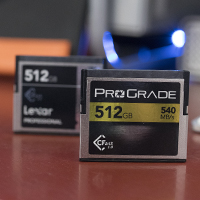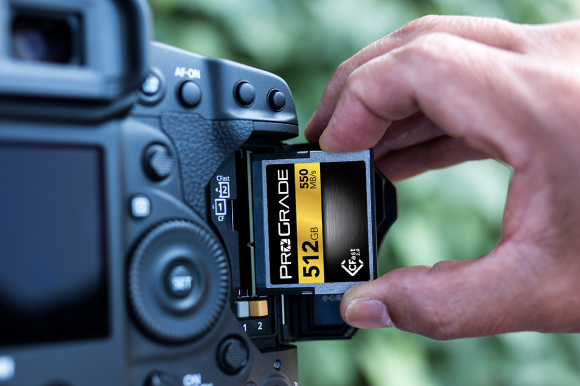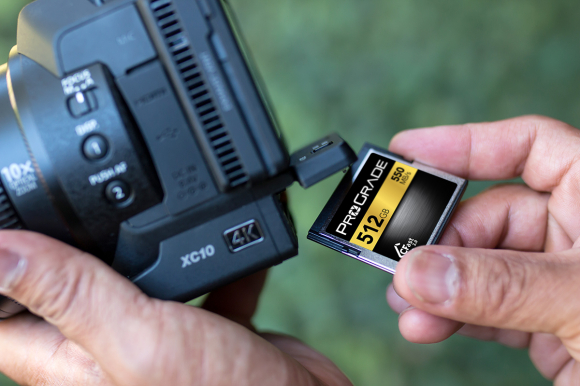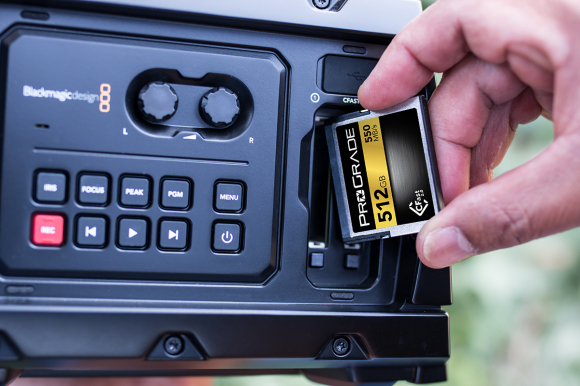Rising from Lexar’s ashes, ProGrade Digital is redefining quality in memory
posted Thursday, February 15, 2018 at 11:00 AM EDT

In the fall of 2016, I found myself in a warmly lit, large and bright conference room accentuated by a beautiful sunny day streaming in from wide windows in the Silicon Valley office of Micron. Micron, the at-the-time parent company of memory card goliath Lexar, was celebrating the memory card company’s 20 year anniversary and announcing a few new products in the USB space that would be going public a few days later.
Afterwards, I shook hands with a few Lexar executives and was offered a sit down with Wes Brewer, the then VP and General Manager of the Lexar group. What resulted from that conversation was my piece on CFExpress and the sooner-rather-than-later death of CFast. It was the most enlightening conversation I’ve ever had about memory, and I was excited to continue my relationship with Lexar and looked forward to future conversations with Wes.
A year later, Lexar by Micron was dead.
For me, an avid Lexar fan since my first digital camera, it was heartbreaking. I had seen several of my favorite companies in the industry come and go, but losing Lexar hit me especially hard. They were the first big company that acted like a small company, and they actually had treated me extremely well as a customer. I once had a CFAST card corrupt in my 1DX Mark II and with it, 128 GB of one-of-a-kind, irreplaceable footage from a project we were shooting for the UCSD Scripps Institute of Oceanography.
Lexar not only recovered all the footage flawlessly, but in order to do it built an entirely new software from scratch that was designed to recover video footage. Wes later told me he had a personal hand in helping get that software out the door.
Just a couple weeks ago, I found myself again sitting across from Wes Brewer, but this time in a new, much smaller office comprised of just five individuals. In front of me was Mark Lewis, former Senior Director of Marketing at Lexar, and Wes, and a new memory card branded “ProGrade Digital.” Mark wore the new title of VP of Marketing for ProGrade Digital, and Wes the title of CEO.

Much had changed, and it had been less than a year since Lexar by Micron shuttered. But what happened? In just a few short months, Lexar was there and then suddenly wasn’t.
“The market for nand flash really started to tighten shortly after we last met with you,” Wes told me. “The transition to 3D memory was hitting the market hard.”
3D memory is the idea that instead of trying to shrink silicon smaller while increasing density, you instead built up. When you run out of room in the X and Y axis but the demand for more space still exists, you have no choice but to move to the Z axis. Shrinking silicon smaller had reached its limit. “You have to move individual atoms to store a charge and we simply could not get smaller,” Wes recounted. “When you run out of room, you have to go vertical, you have to go up. The fundamental tech of 3D is to go up in the Z direction.”
Wes told me that the entire memory industry actually stepped back to slightly older technology in order to move into 3D memory. They moved back to Triple Level Cell (TLC) and went vertically from there. “So right now the industry is starting at TLC and then stacking each wafer or dye vertically and interconnecting them all through a common interface,” Wes explained. “The challenge now is how many can you stack in a given Z height? It started at 48 layer, and then there was a next step at 72 and now there is a 96 and of course people will be pushing beyond that.”
“The transition to 3D memory was hitting the market hard.”
Wes explained that Micron was a leader in this space. “Even in 2016 they were doing this with MLC (2 layers) and now they’re on to TLC,” he said. So why did this affect the industry? What made the markets tighten? “The transition from 2D memory to 3D memory requires a lot of capital,” Wes explained. “The conversion of fabricators was hard, and the industry may have underestimated how much work this was going to be. So there was a dip in supply as companies were converting factories to the new 3D fabricators. Compounding this was the fact that the data centers for cloud storage was going nuts (Amazon, Apple, Google, and Facebook all drove demand).”
Solid state drives, which were originally being primarily used as cache memory for front-end speed, were transitioning to becoming the actual storage device. That drove up demand for SSD when the industry was already short on supply due to this transition. “The industry still hasn’t fully recovered,” Wes said. “The equipment is very expensive to produce 3D. We’re talking $5 billion to make a new fab for 3D.”
You can see how this would cause rippling effects through the industry.
“That shortage of supply meant that manufacturers had to decide where they were going to put their capital, and what markets they were going to serve,” Wes explained. "At Micron, that was data centers and enterprise storage. So then they asked themselves if they really wanted to be producing a $4.99 USB drive to be sold at Target and not make any money with the heavy complexity of retail costs and things like that.”
For obvious reasons, Wes couldn’t go into more detail regarding the decisions at Micron that led to the eventual sale of Lexar, but it’s pretty obvious that Micron made their decision, and what that decision ended up being. They chose to leave the consumer industry storage market altogether, selling off the Lexar brand to Longsys in the second half of 2017. Here’s the thing though: Mircon only sold the Lexar name and existing product. They didn’t buy the people (just a few), and they didn’t buy the underlying tech.
“That shortage of supply meant that manufacturers had to decide where they were going to put their capital, and what markets they were going to serve.”
Wes continued, “When it came down that they had to shut down, they had to plan for an exit after the year (2017). By that fall, it was pretty much all over. All Lexar by Micron product was to stop, and they announced a buyer. They took some folks, just a few, not too many. What transpired at that point was I started thinking, ‘I’m going to be out of a job by December.’”
Wes got together with a small group of seasoned Lexar veterans and devised a plan. “We said, we know that there is still a very lucrative market for professional media and workflow accessories like readers,” he explained. “We knew that Longsys was going to take some time in transition and that there was an opportunity. We also knew that SanDisk lost some key people in their marketing team and that this wasn’t necessarily a focus for them right now and they were having the same struggles [with 3D memory] that I mentioned.
“We said 'hey, I think we can probably manage to get the supply we need through the relationships we developed at Micron over the years.’ Our needs for supply are very small compared to when we were at Micron, and if we partner with somebody closely that we have worked with in the controller space and the manufacturing space on the contract manufacturing side we can make a business out of this.
“So that’s what we did.”

“I put together a business plan and got together with a few guys I had worked with over the years,” he said. “I was 10 years at SanDisk and helped build their whole retail business plus our time at Lexar.
“[I got] the group of us with a lot of experience, over 60 years of combined industry experience, to create a new brand called ProGrade Digital to signify our focus which is professional grade memory."
I looked down at the table and did the math in my head. “You haven’t even been in business for a year and you already have product?”
“I conceived the idea of ProGrade in August of last year,” Wes responded, smiling.
Sitting across from Wes, thinking over what he had said, boggled the mind. It was just eight months after he conceived the idea of ProGrade Digital and already I was holding a working product in my hands. ProGrade has no “Kickstarter” plan, no crowd funding, no period of “trust us, we’ll deliver a product in a year if you just send us $100.” No, Wes and his team did it the old way. The better way. They leveraged their relationships, dug in and built a product and a brand from the ground up at a rate that I’ve never seen. It is truly unprecedented. It doesn’t seem possible, and yet the ProGrade CFast card was already in my camera, and it worked.
They have a physical product right now less than a year from when it was just an idea. And a 512GB CFast card that’s the fastest on the market, at that.
They are ready to go, product on hand, right now. Today.
“At Lexar by Micron, when we got to an overall 2% failure rate on a pro card, then the alarms started going off. That’s not good enough for us. We’re going for 0% failure rate.”
To top it off, our testing has shown this to be the fastest to read CFast card out there, and the fastest 512GB in write speed that we’ve tested. Not even SanDisk is producing 512GB CFast cards yet. There are a couple others out there now, but reviews look poor. They just aren’t reliable.
And reliability is paramount to ProGrade. They’re going beyond anything anyone has ever done before to assure every card is perfect.
You see, before ProGrade, there was kind of a “standard” of how cards are produced and tested in the industry. “The way the industry generally works, whether it’s USB flash or a card, is you do all the testing when you do the design,” Wes explained. “You beat the hell out of the base level design, like the controller, the firmware, the memory packaged in a certain way. You run it through temperature extremes, bend and twist, do everything to it, lots of benchmarking.
“Then you go to the factory and you say, ‘Well if I use the exact same component group, built the exact same way that I did all the hard testing, then I need to only do a simple functional test. You take it off the line, it’s finished being produced, Read, write, real quick you take it out, send it off 45 seconds later.’
“We know that’s not the best way. We are doing 100% testing of every memory location in every card at the factory. That can take 45 minutes vs. the aforementioned 45 seconds,” he said as he leaned in towards me and held his CFast card up proudly. “The cards you get from us, every memory location has been written to at least once in a controlled factory location. No one else is doing that."
Why? Because it’s expensive, but ProGrade cares more about a better product than more profit. “We’re putting a ton of time into testing,” Wes said. To put things in perspective, “At Lexar by Micron, when we got to an overall 2% failure rate on a pro card, then the alarms started going off. That’s not good enough for us. We’re going for 0% failure rate.”
ProGrade wants every card they send out to work every time, with no failures. And on the off chance any card has a problem, they’ve individually serial numbered each card that has specific information that can be relayed to the ProGrade team. With that serial number, they know where and when that card was made and can more quickly diagnose a fix. From every angle, ProGrade is putting more effort towards creating a reliable, excellent product than anyone else in the industry.

And they’re just getting started.
Their focus today is with CFAST and UHS-II U-3 SD, with more to come in the future that we’ll talk about soon that I think is very exciting.
“We’re going up to 200 MB/s read speed on our UHS-II SD cards right now. We are balancing the spot between price and speed, and providing the most critical functionality in cards, which is U-3.”
Sony requires U-3 in their recent cameras, for example. Without it, the cameras will reject the card.
“It’s a balance between price and performance in SD, but we’re going for the max performance in CFAST,” Wes explained.
Rolling out a brand new product is not a fast nor easy task, and ProGrade will be taking things one step at a time. For now, you can only purchase their products directly from their website or through Amazon and B&H. “We are focused on United States and North America, with Europe next on our radar, along with China and Japan,” Wes said. After that, they hope to be available around the world.
Personally, I could not be more excited to see ProGrade come to market. After Lexar bowed out last year, it left a hole that I wasn’t sure who was going to fill. Knowing that the team at ProGrade was responsible for the best parts of Lexar gives me extreme hope that they will become the next household name in memory. For the betterment of our industry, we should all be cheering them on and wishing them success.